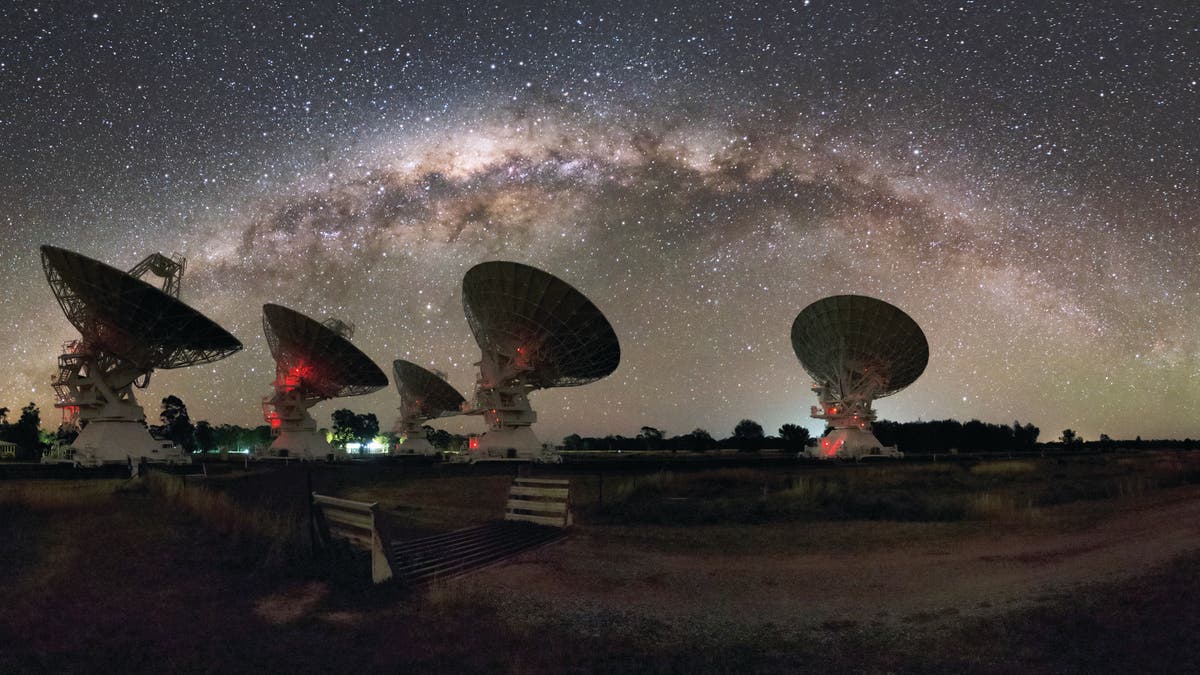
CSIRO's Compact Array in Australia. (Alex Cherney)
For the first time, unusual radio signals that long befuddled scientists have been traced to a distant galaxy as much as 6 billion light years away.
These fast radio bursts (FRBs) - spectacular flashes of radio waves originating in the distant universe - emit as much energy in one millisecond as the Sun does in 10,000 years.
They were discovered in 2007 but only 17 bursts have been found, even though astronomers estimate that they might occur 10,000 times a day across the entire sky. Its unclear what causes them.
Related: Scientists release in-depth map of the Milky Way
“Our discovery opens the way to working out what makes these bursts,” said Simon Johnston, head of astrophysics at Australia’s Commonwealth Scientific and Industrial Research Organisation and a co-author on the paper on the FRBs in Nature this week.
Not only does the study confirm the existence of FRBs but researchers said it could allow scientists to use them to find matter in the universe that has “gone missing.”
Astronomers believe the contents of the universe are 70 percent dark energy, 25 percent dark matter and 5 percent ordinary matter. But so far, they have only been able to find half as much when adding up the matter in all of the stars, galaxies and hydrogen gas.
Using the burst (FRB 150418) as a tool, the international team was able to ‘weigh’ the universe, or at least the normal matter it contains.
“The good news is our observations and the model match - we have found the missing matter,” Evan Keane, from the SKA Organisation and the lead author on the paper, said. “It’s the first time a fast radio burst has been used to conduct a cosmological measurement.”
Related: Astronomers find supermassive black hole in giant galaxy 300 million light years away
Until recently, most FRBs were found by sifting through all the recorded data. It was a slow process that resulted in them often being found years after the fact.
Keane and his team came up with a system that could detect them in seconds and thus allowing scientists to alert other telescopes with an exact location.
Using CSIRO’s Parkes telescope, the researchers detected the new FRB last April. Two hours later, CSIRO’s Compact Array telescope homed in on the patch of sky the flash had come from. It saw a radio source that lasted for six days before fading - the FRB’s radio afterglow.
This let the researchers to zoom in on the FRB about 1,000 times more precisely than any of the previously detected bursts.
Meanwhile in Hawaii, the 8.2-m optical Subaru telescope found a galaxy that could be matched with the radio source seen by the Compact Array. A further investigation revealed the object was an elliptical galaxy - a huge football-shaped mass of stars about six billion light-years away.
Related: Scientists find evidence of gravitational waves predicted by Einstein
“This is not what we expected,” Johnston said. “It might mean that the FRB resulted from, say, two neutron stars colliding rather than anything to do with recent star birth.”
West Virginia University’s Duncan Lorimer, who discovered the first FRB and wrote a News & Views piece that accompanied the study, said he expects many more will be found in the future. They could among other things help inform our understanding of the sources for them – including collapsing neutron stars, evaporating blackholes or even non-stellar phenomena such as cosmic strings.
“There are good reasons to think that our understanding of FRBs will increase dramatically in the near future,” he wrote, noting that new telescopes like the Canadian Hydrogen Intensity Mapping Experiment and the Fivehundred-meter Aperture Spherical Telescope in China, should prove critical in this search.
“It is reasonable to expect many hundreds of observed FRBs by the end of the decade,” he continued. “A large census of FRBs will not only add to our understanding of their population, but also map out the cosmic web in great detail, provide stringent tests of general relativity and even yield new constraints on the nature of dark energy.”
